"It came seventeen years ago - and to this day, it has shown no intention of going away."
In 1962, the leader of cinematic surrealism, Luis Buñuel, made a darkly comical movie called The Exterminating Angel about dinner party guests who cannot leave the house after dinner. Or rather, they do not leave. After a day or two, the scene descends into feral, madness. And yet, we never know why they refuse to leave. Nothing is said or discussed; they simply remain. Buñuel plays with this unanswered psychological question: Why don't they leave?
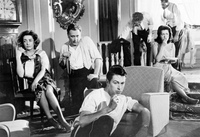 Buñuel’s The Exterminating Angel (1962). Photograph from The Ronald Grant Cinema Archive.
Buñuel’s The Exterminating Angel (1962). Photograph from The Ronald Grant Cinema Archive.Surrealism, although intended to be aesthetically irrational, was, like all art, a method of expression. It developed in an irrational world where poets were killed, and libraries were burned, all while fascists (a truly chaotic system) governed. In that context, an invisible, paralytic force that detains people at a dinner party fits.
Less than ten years before Buñuel's masterpiece, American illustrator Edward Gorey (February 22, 1925 – April 15, 2000) illustrated a short, equally frightful poem called The Doubtful Guest, which included the same posh dinner party, a grand house, and a menacing threat of chaos in the form of a vaguely familiar but creepy creature who comes to stay and will not leave. Moreover, the house's inhabitants do not try to make it leave.
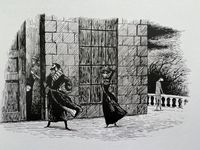 "When they answered the bell on that wild winter night, there was no one expected - and no one in sight."
"When they answered the bell on that wild winter night, there was no one expected - and no one in sight."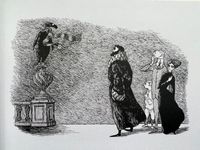 "Then they saw something standing on top of an urn, whose peculiar appearance gave them quite a turn."
"Then they saw something standing on top of an urn, whose peculiar appearance gave them quite a turn."Gorey was not a surrealist, but his metaphor of people paralyzed by fear and change parallels Buñuel's. What are these people afraid of? Why don't they leave or, in Gorey's case, make the Guest leave? It is never stated, but we might suppose it is to protect the balance of a system on which they exist. To leave the dinner party, to vacate the house (or exterminate the guest) means leaving the immediate comfort of their entitled existence for something unknown. Except their comfort erodes anyway...
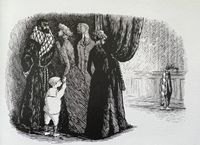 "All at once it leapt down and ran into the hall, where it chose to remain with its nose to the wall."
"All at once it leapt down and ran into the hall, where it chose to remain with its nose to the wall."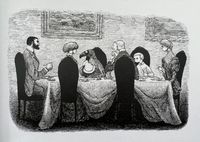 "It joined them at breakfast and presently ate all the syrup and toast and part of a plate."
"It joined them at breakfast and presently ate all the syrup and toast and part of a plate."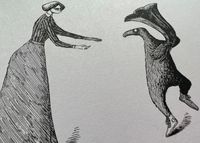 "It wrenched off the horn from the new gramophone, and could not be persuaded to leave it alone."
"It wrenched off the horn from the new gramophone, and could not be persuaded to leave it alone."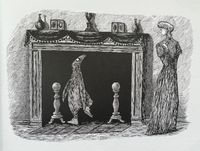 "It betrayed a great liking for peering up flues and peeling the soles off white canvas shoes."
"It betrayed a great liking for peering up flues and peeling the soles off white canvas shoes."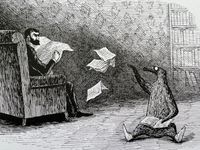 "At times it would tear out whole chapters of books, or put roomfuls of pictures askew on their hooks."
"At times it would tear out whole chapters of books, or put roomfuls of pictures askew on their hooks."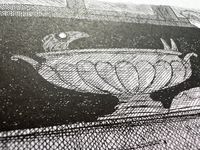 "Now and then it would vanish for hours from the scene, but alas, be discovered inside a tureen."
"Now and then it would vanish for hours from the scene, but alas, be discovered inside a tureen."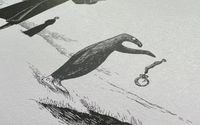 "It would carry off objects of which it grew fond, and protect them by dropping them into the pond."
"It would carry off objects of which it grew fond, and protect them by dropping them into the pond."The Doubtful Guest is a short work but one of Gorey's earliest, done in 1957. It is playful, yes, but also menacing. Gorey was famous for his cross-hatched shadows: that is where the terror lurks. The unknown is hinted at but never shown. The unknown is so frightening, that the Guest is never made to leave.
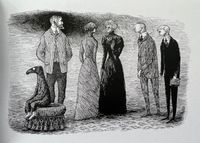 "It came seventeen years ago - and to this day, it has shown no intention of going away."
"It came seventeen years ago - and to this day, it has shown no intention of going away."The components depicted in these illustrations suggest that Gorey might have been English-born and raised (he was a New Yorker). I've lived in England for a decade now, and there is an inescapable darkness: in the damp corners, the sordid past, thickly-lined draperies, the sun's low arc, the unbreakable arrogance of class. Gorey's most famous artistic partnership was redoing the original illustrations for T. S. Eliot's fantastic feline-inspired verse Old Possum's Book of Practical Cats. Gorey turned Eliot's well-imagined characters into distinct class emblems, from the authority-slipping shenanigans of Mr. McCavity to the arrogant, fatuous Bustopher Jones. It is easy to see why Gorey wanted to enhance these characters who were as interesting, complex, and emblematic as the Guest.


